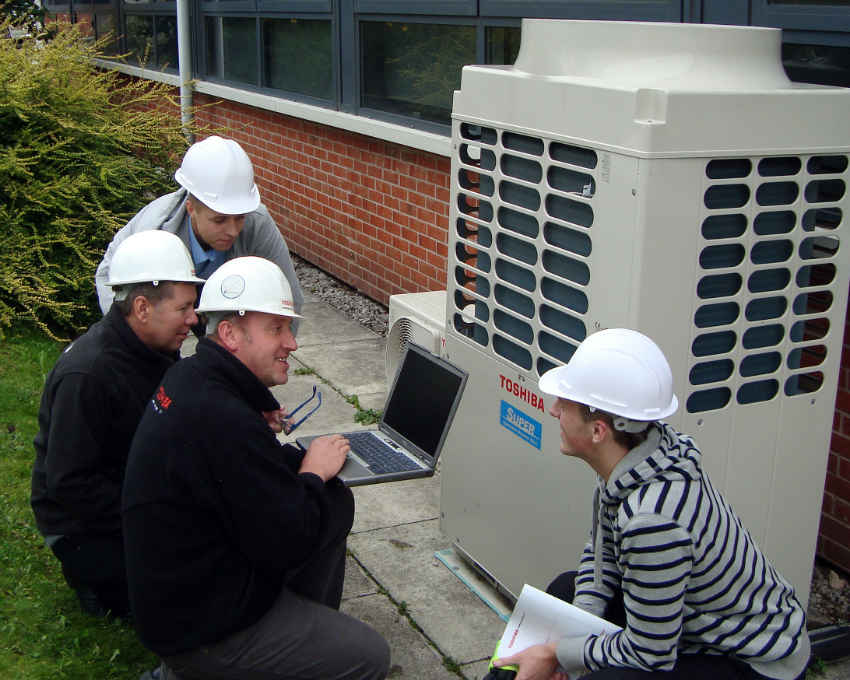29 December 2015
|
By Neil Wooldridge, Technical Manager, Toshiba Air Conditioning
The term pump-down is used to refer to a number of different procedures involving the transfer of refrigerant within an air conditioning system.
The term pump-down is used to refer to a number of different procedures involving the transfer of refrigerant within an air conditioning system.
It is commonly used to describe a process that involves drawing as much of a system’s refrigerant as possible into an outdoor unit, to enable work to be carried out on the refrigerant circuit external to the outdoor unit (indoor units, FS-Boxes and pipework).
The idea is to use the compressor on the outdoor unit to evacuate refrigerant from the system into the outdoor unit. The percentage of a system’s charge that can be pumped into the outdoor unit will depend on the ambient temperature, pipe separation between indoor and outdoor units and the outdoor unit’s internal volume.
Any refrigerant left in the pipework must then be recovered using a refrigerant recovery machine.
The term pump down can also be used to refer to the transfer of refrigerant from a failed outdoor unit to a working outdoor unit, using the good unit’s compressor.
In the case of a system with a single outdoor unit, where the outdoor refrigerant circuit requires a repair, this is normally achieved by isolating the service valves at the outdoor unit and either recovering the refrigerant from the outdoor unit to a service cylinder using a reclaim machine, or by using the reclaim machine to pump refrigerant from the outdoor unit to the system pipework. The second option simply uses the pipework for containment rather than a cylinder.
From this, it can be seen that refrigerant pump down and recovery processes are numerous and varied, and involve different techniques.
Any refrigerant left in the pipework must then be recovered using a refrigerant recovery machine.
The term pump down can also be used to refer to the transfer of refrigerant from a failed outdoor unit to a working outdoor unit, using the good unit’s compressor.
In the case of a system with a single outdoor unit, where the outdoor refrigerant circuit requires a repair, this is normally achieved by isolating the service valves at the outdoor unit and either recovering the refrigerant from the outdoor unit to a service cylinder using a reclaim machine, or by using the reclaim machine to pump refrigerant from the outdoor unit to the system pipework. The second option simply uses the pipework for containment rather than a cylinder.
From this, it can be seen that refrigerant pump down and recovery processes are numerous and varied, and involve different techniques.
Sponsored Link: Need a refrigerant recovery unit? Click here to see JAVAC's range
Modern VRF Systems
On early VRF systems, transferring refrigerant between outdoor units was relatively straightforward, due to the comparative simplicity of the design. With today’s modern systems, however, the procedure is more complex.
In our experience, this approach is rarely used as it has little benefit to the engineer, as he will still need to remove the final residual refrigerant with a reclaim machine.
In practice, engineers can simply isolate the affected outdoor unit at the service valves and either recover to a service bottle or to the pipework. Once the work has been carried out, and the outdoor unit pressure/leak tested and evacuated, refrigerant is then released back into the unit.
An even more efficient option is available to engineers on systems equipped with Toshiba’s award-winning RD6 leak detection and management system.
This is primarily designed to monitor an air conditioning system for refrigerant leaks and, in the unlikely event of refrigerant loss, automatically pump down the system to prevent further leakage - until the source of the leak can be identified and repaired.
However, RD6 also enables engineers to activate a full pump down at the flick of a switch, overcoming the need for the usual sequence of manual steps, thereby speeding up the whole process.
In our experience, this approach is rarely used as it has little benefit to the engineer, as he will still need to remove the final residual refrigerant with a reclaim machine.
In practice, engineers can simply isolate the affected outdoor unit at the service valves and either recover to a service bottle or to the pipework. Once the work has been carried out, and the outdoor unit pressure/leak tested and evacuated, refrigerant is then released back into the unit.
An even more efficient option is available to engineers on systems equipped with Toshiba’s award-winning RD6 leak detection and management system.
This is primarily designed to monitor an air conditioning system for refrigerant leaks and, in the unlikely event of refrigerant loss, automatically pump down the system to prevent further leakage - until the source of the leak can be identified and repaired.
However, RD6 also enables engineers to activate a full pump down at the flick of a switch, overcoming the need for the usual sequence of manual steps, thereby speeding up the whole process.
Details:
A copy of Toshiba’s Service Manual for Modular Air Conditioning (A12-006) can be downloaded from: www.toshiba-aircon.co.uk
For more details on Toshiba’s RD6 refrigerant leak detection and management system, see: www.toshiba-aircon.co.uk/news/article/toshiba-introduces-next-big-advance-in-refrigerant-leak-protection-for-buil
A copy of Toshiba’s Service Manual for Modular Air Conditioning (A12-006) can be downloaded from: www.toshiba-aircon.co.uk
For more details on Toshiba’s RD6 refrigerant leak detection and management system, see: www.toshiba-aircon.co.uk/news/article/toshiba-introduces-next-big-advance-in-refrigerant-leak-protection-for-buil
Content continues after advertisements









